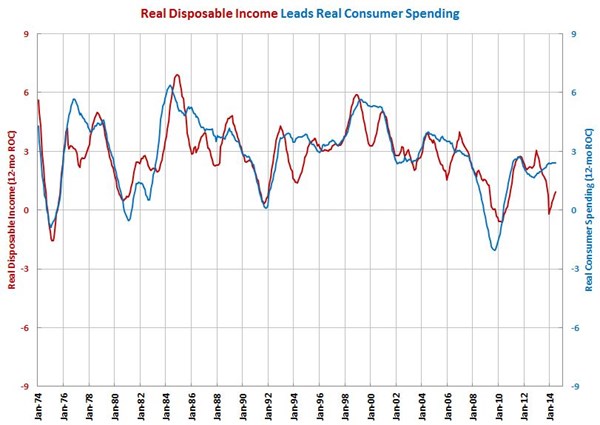Consumer Spending Growth Rate Unchanged in June
The annual rate of change has been stuck at 2.4% since November 2013. This is still about 33% below the historical average growth rate in consumer spending.
According to the Bureau of Economic Analysis, real consumer spending in June 2014 was $10,929 billion real dollars (seasonally adjusted at an annual rate). The month-over-month rate of growth in consumer spending remained at 2.3% for the second month. The month-over-month rate of change has been between 2.0% and 2.7% every month but one since November 2012. The annual rate of change has been stuck at 2.4% since November 2013 (almost as if it has been goal seeked). This is still about 33% below the historical average growth rate in consumer spending.
Real disposable income, a good leading indicator for real consumer spending, has been growing faster for five months. However, the rate of growth of growth is relatively anemic in historical terms. The rate of growth in consumer spending is significantly higher than the rate of growth in disposable income. However, these two curves usually track each other quite closely. Therefore, even if the rate of growth in incomes continues to accelerate, there may not be much improvement in the growth rate of consumer spending.
While total consumer spending has been growing significantly slower than the historical average rate, real consumer durable goods spending has been growing nearly 20% faster than the average historical rate. In June, consumer durable goods spending reached an all-time high, and the rate of growth compared to one year ago fell just slightly to 6.8%. Annually, the rate of growth has decelerated for the first time in three months. Durable goods spending continues to make up a larger share of all consumer spending due to the ultra-low interest rates. In June, durable goods spending was 14.8% of all consumer spending, which is the highest percent ever.
Real consumer spending (or its sub-components such as medical care spending) is an important leading for a number of durable goods end markets: construction materials;custom processors; durable goods; food/beverage processing; forming/fabricating (non-auto); hardware; HVAC; industrial motors/hydraulics/mechanical components; machinery/equipment manufacturing; medical; metalcutting job shops; oil/gas field/mining machinery; power generation; primary metals; and printing.



.JPG;width=70;height=70;mode=crop)